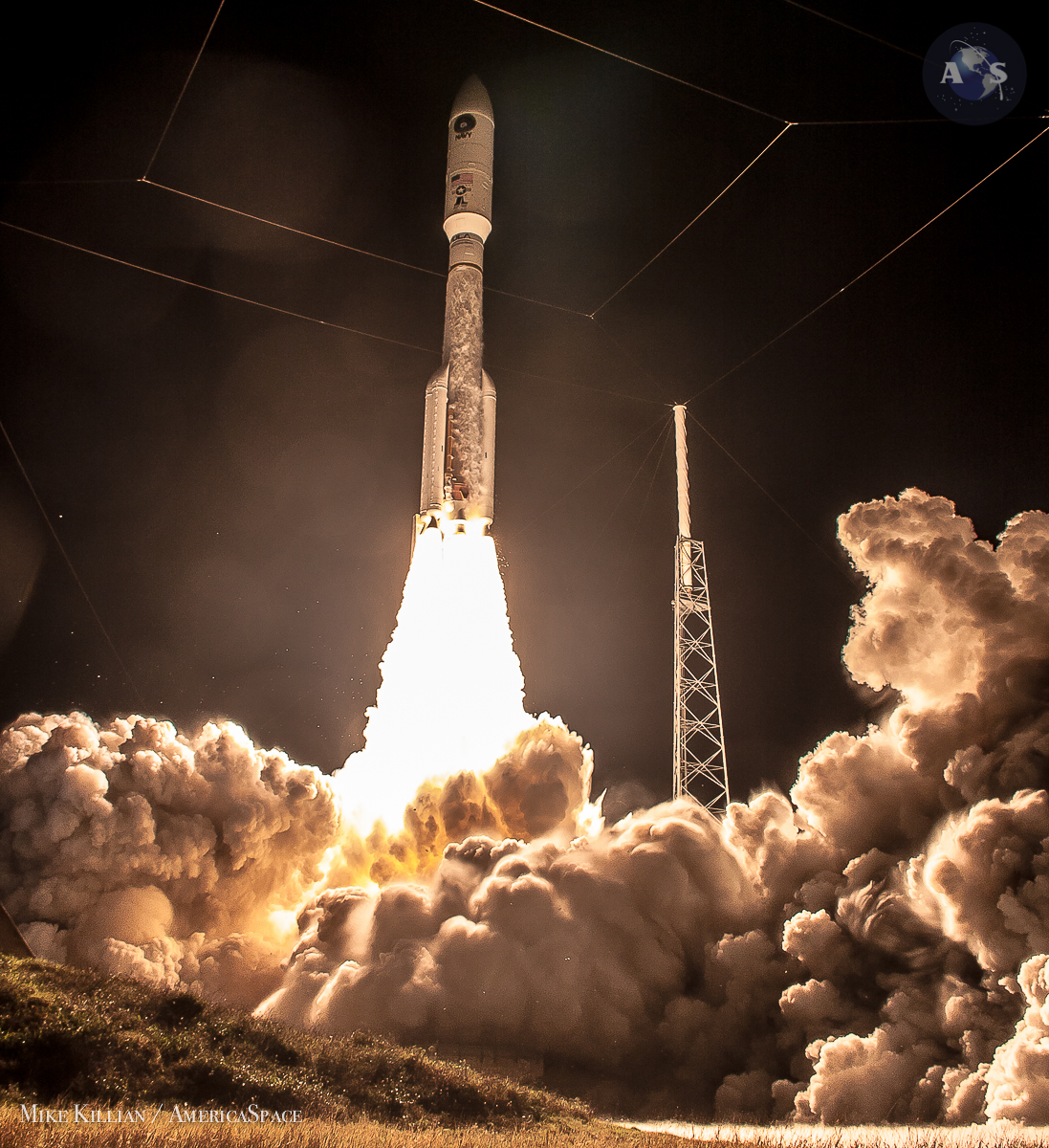
United Launch Alliance (ULA) has successfully begun the delivery of one of its largest and heaviest payloads—the latest member of the U.S. Navy’s Mobile User Objective System (MUOS) constellation of next-generation narrowband tactical satellites—on a journey into geostationary transfer orbit, with an eventual apogee of 22,240 miles (35,790 km). Liftoff of the 206-foot-tall (62.8-meter) Atlas V rocket from Space Launch Complex (SLC)-41 at Cape Canaveral Air Force Station, Fla., occurred at 8:04 p.m. EST Tuesday, 20 January, about 21 minutes into the 44-minute “window.” The launch was slightly delayed, due to Eastern Range command interference issues and high-level winds, both of which were subsequently cleared. Powered uphill by the Russian-built RD-180 engine of its core stage and supplemented by five strap-on, solid-fueled boosters, this was only the fifth occasion in the Atlas V’s 13-year history that it has flown in its most powerful “551” configuration. Orbital insertion of the MUOS-3 payload was expected a little under three hours into the mission.
As described in Monday’s AmericaSpace preview article, the Atlas V 551 sailed through a successful Launch Readiness Review (LRR) on Friday, 16 January, allowing teams to press ahead with Tuesday evening’s opening launch attempt. Rollout of the stack atop its Mobile Launch Platform (MLP) from the Vertical Integration Facility (VIF) at the Cape on the quarter-mile (400-meter) journey to the pad began at 10:01 a.m. Monday. After reaching SLC-41, the Atlas V was carefully centered and propellant umbilicals and electrical and data links were connected. Initial predictions for a 60 percent likelihood of acceptable weather—with the Thick Cloud Rule identified as the main violating factor—steadily improved through Tuesday.
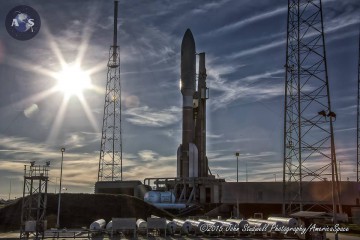
“Today, high pressure migrates east as the next upper-level disturbance advances toward the peninsula,” noted the 45th Weather Squadron at Patrick Air Force Base. “Considerable cloudiness associated with the disturbance persists through late afternoon. Although a little later in timing, by early evening a drying trend in the mid and upper levels with thinning cloud cover is expected. There is a small threat of an isolated shower, with no thunderstorm threat. Concerning solar weather, there is a low threat of elevated proton flux or high electron flux through the launch opportunities.” Violation of the Thick Cloud Rule remained the primary concern, although the probability of weather conditions being acceptable to support a launch on Tuesday evening had increased to 80 percent favorable, with a similar outlook for the backup opportunity Wednesday.
Formal countdown operations got underway Tuesday afternoon, at T-6 hours and 20 minutes, with the activation of flight control systems, shortly after 1:20 p.m. “Over the next four hours, the rocket will be powered up [and] various system preparations will take place,” explained AmericaSpace’s Launch Tracker, run for today’s mission by Leonidas Papadopoulos. “The flight computer will be tested both for flight control and guidance operations, the countdown clock will be started and other activities preparing for the Terminal Countdown will be carried out.” Ground Command Systems testing occupied about 3.5 hours, as engineers verified communications between the Atlas V and the Launch Control Center (LCC).
The Atlas V’s Common Core Booster (CCB) is fueled by a mixture of liquid oxygen and a highly refined form of rocket-grade kerosene (known as “RP-1”). Since the former undergoes cryogenic boil-off and must be continuously replenished until close to T-0, it was loaded relatively late in the countdown, whereas the RP-1 experiences “no leakage or reduction in capacity during the interval before launch” and consequently was pumped aboard the rocket yesterday. At 5:20 p.m., a built-in hold got underway, prior to the onset of liquid oxygen loading, and propellant storage areas were chilled down, in order to avoid thermally shocking and fracturing the hardware.
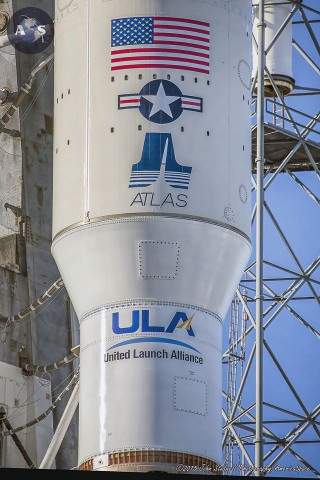
At length, shortly before 6 p.m., as the Sun set over the marshy Florida landscape, the Launch Director authorized the lengthy process to begin. This was followed by the loading of a pair of cryogens—liquid oxygen and hydrogen—aboard the Atlas V’s Centaur upper stage, whose RL-10C engine would execute three “burns” to deliver the 15,000-pound (6,800-kg) MUOS-3 satellite into its correct geostationary position. Liquid oxygen tanking passed smoothly through Slow Fill and Fast Fill modes, before finally transitioning to Topping by 6:20 p.m., in order to continuously replenish the effects of boil-off. Shortly after 6:30 p.m., the process of loading liquid hydrogen aboard the Centaur got underway.
Overall, the Atlas V was enjoying a trouble-free countdown, as described by the Launch Tracker at T-60 minutes. “Fueling is well underway and will shortly be completed,” it was highlighted. “The weather remains favorable at 80-percent Go and we are not aware of any issues being worked at this time.” High-altitude balloon data in the final minutes before launch confirmed an improvement in the likelihood of acceptable weather conditions to 90 percent favorable.
With all tanks confirmed at flight levels, the final checkout of the Flight Termination System (FTS)—which is tasked with destroying the vehicle in the event of a major accident during ascent—was performed and the ascent software was updated. At 7:24 p.m., the countdown entered its final 15-minute built-in hold at T-4 minutes, during which time ULA Launch Conductor Scott Barney took the opportunity to undertake last checks on the vehicle, payload, and weather situation. During this period, issues with Eastern Range command interference and unacceptable upper-level winds forced the movement of T-0 to 7:49 p.m., about six minutes into the 44-minute window. However, as engineers pressed on with their efforts, it soon became clear that they could not meet the new launch time and a revised T-0 of 7:59 p.m. was set. The weather turned from “Red” (“No-Go”) to “Green” (“Go”) by 7:56 p.m., but the command interference issue remained to be resolved. Since this included the FTS, it was imperative that it was cleared before the launch could go ahead, and a revised T-0 of 8:04 p.m. was established.
In the meantime, at 7:57 p.m., Mr. Barney led a final “Go-No Go” poll of all stations, and at 8:00 p.m., with the Range interference issue finally rectified, the clock was released from its final hold point at T-4 minutes and the Terminal Countdown got underway. During this phase, the Atlas V systems were transferred to internal power, the FTS was armed, and at T-60 seconds the Launch Control System was enabled and the vehicle’s computer assumed primary command of all critical functions. “Range Green!” came the call from the Range Operations Co-ordinator (ROC).
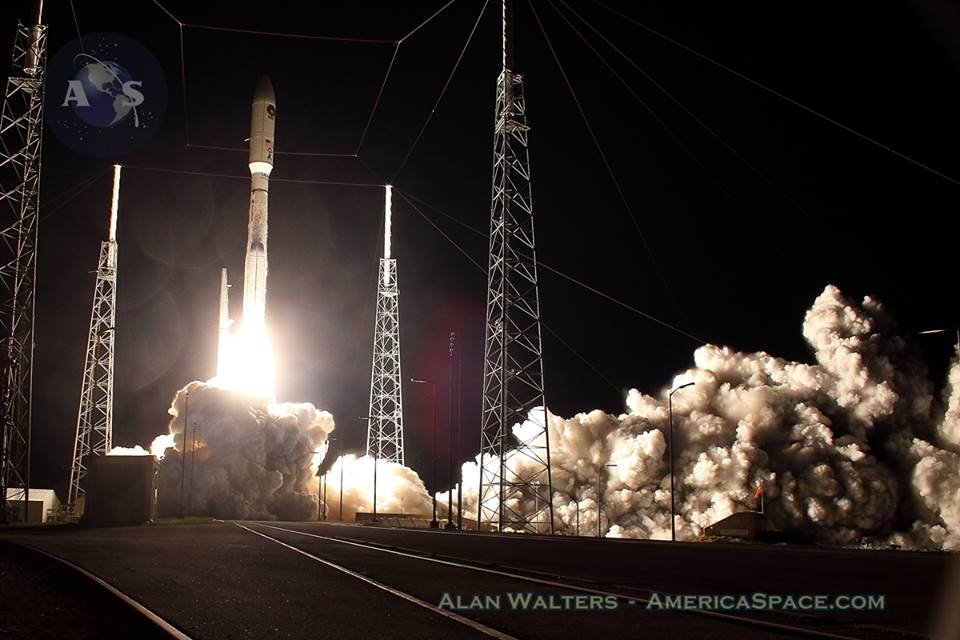
Launch got underway at T-2.7 seconds, with the ignition of the Russian-built RD-180 first-stage engine, burning liquid oxygen and RP-1 and generating 860,000 pounds (390,000 kg) of propulsive yield. The five Aerojet-built solid-fueled boosters, each measuring 67 feet (20.4 meters) tall, also ignited and produced a total thrust of 1.7 million pounds (790,000 kg) to supplement the initial boost away from the darkened Cape. Climb-out of the stack from SLC-41 commenced at T+1.1 seconds, beginning a fast climb to about 85 feet (26 meters), after which the avionics of the Centaur upper stage—flying for the 200th time in conjunction with a member of the Atlas rocket family—commanded a pitch, roll, and yaw program maneuver to establish the Atlas onto the proper flight azimuth of 94.58 degrees in order to deliver the MUOS-3 payload into orbit.
Fifty-one seconds into the flight, the vehicle passed through maximum aerodynamic turbulence—colloquially known as “Max Q”—and the rapidly ascending stack throttled down its RD-180 engine and began a nominal zero-pitch and zero-yaw angle of attack to minimize these loads. At T+110.7 seconds, now exhausted, two of the five strap-on boosters were jettisoned, followed by the others about 1.5 seconds later. A little over 3.5 minutes into the mission, with the RD-180 still burning hot and hard, the bulbous payload fairing was discarded, and when the 551 reached a peak load of 4.6 G the engine was throttled back to maintain this level.
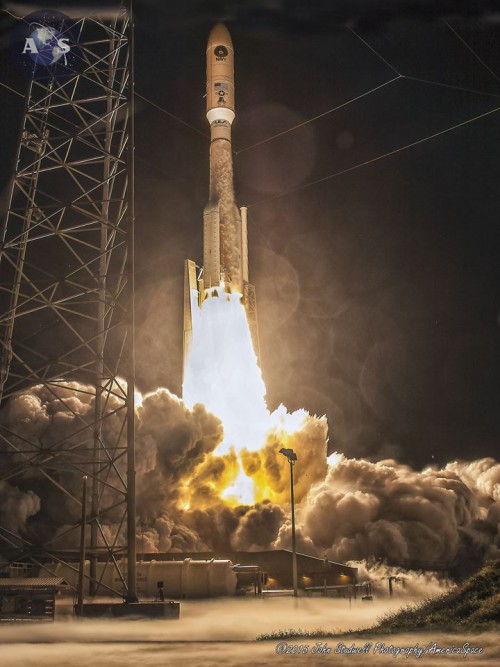
Shutdown—properly identified as Booster Engine Cutoff (BECO)—took place at T+267.6 seconds, after which the 41.5-foot-long (12.6-meter) Centaur and its attached MUOS-3 payload separated. To support the delivery of the satellite into its correct orbital “slot,” the Centaur will perform three lengthy firings of its 23,900-pound-thrust (10,840-kg) RL-10C engine. First trialed during last month’s NROL-35 mission for the National Reconnaissance Office, the liquid oxygen/hydrogen-fueled RL-10C measures 7 feet (2.2 meters) long and 4.5 feet (1.4 meters) in diameter and has a dry mass of 420 pounds (190 kg). Although its overall thrust is slightly higher than the 22,300 pounds (10,100 kg) of the earlier RL-10A, the upgraded engine’s specific impulse is a little lower than its counterpart.
The first burn will last almost eight minutes, kicking off at T+283.6 seconds and terminating at T+750.4 seconds. The Centaur/MUOS-3 combo will then coast for a further eight minutes, before the RL-10C ignites for its second burn at 20 minutes and 32 seconds into the mission. This firing is scheduled to run for just under six minutes, steering the payload stack into an intermediate transfer orbit, and will be followed by a substantially longer period of coasting—more than two hours—before the third and final burn gets underway at T+2 hours and 48 minutes. This burn will last about 59 seconds and will deliver MUOS-3 into the Spacecraft Separation Transfer Orbit. When the Centaur’s targeted orbital parameters are achieved, Main Engine Cutoff (MECO) will be initiated by guidance command, and the satellite will separate from the upper stage about two hours and 53 minutes after leaving Cape Canaveral Air Force Station. Nominal insertion orbit will be at an apogee of 22,240 miles (35,790 km) and a perigee of 2,370 miles (3,820 km), inclined 19.11 degrees to the equator.
Upon reaching its operational location, high above the Atlantic Ocean, MUOS-3 will join its siblings in the provision of global satellite communications narrowband (64 kbits/sec and lower) connectivity for U.S. and allied military forces, with a UHF range from 300 MHz-3 GHz. When fully functional, it will replace the legacy UHF Follow-On (UFO) satellite network—the first of which was launched way back in March 1993—before the latter system reaches the end of its operational lifetime. MUOS provides new capabilities and enhanced mobility, access, capacity, and quality of service, with particular emphasis upon mobile users, such as aerial and maritime platforms, ground vehicles, and dismounted soldiers. It will extend their voice, data, and video communications far beyond the physical lines of sight. By performing in the UHF band, which is lower than conventional cellular networks, MUOS thus provides U.S. and allied warfighters with the tactical ability to communicate in “disadvantaged” environments, including heavily forested areas, where higher-frequency signals would be otherwise impaired. Even troops in buildings with no satellite access are expected to see an increase in communications capability.
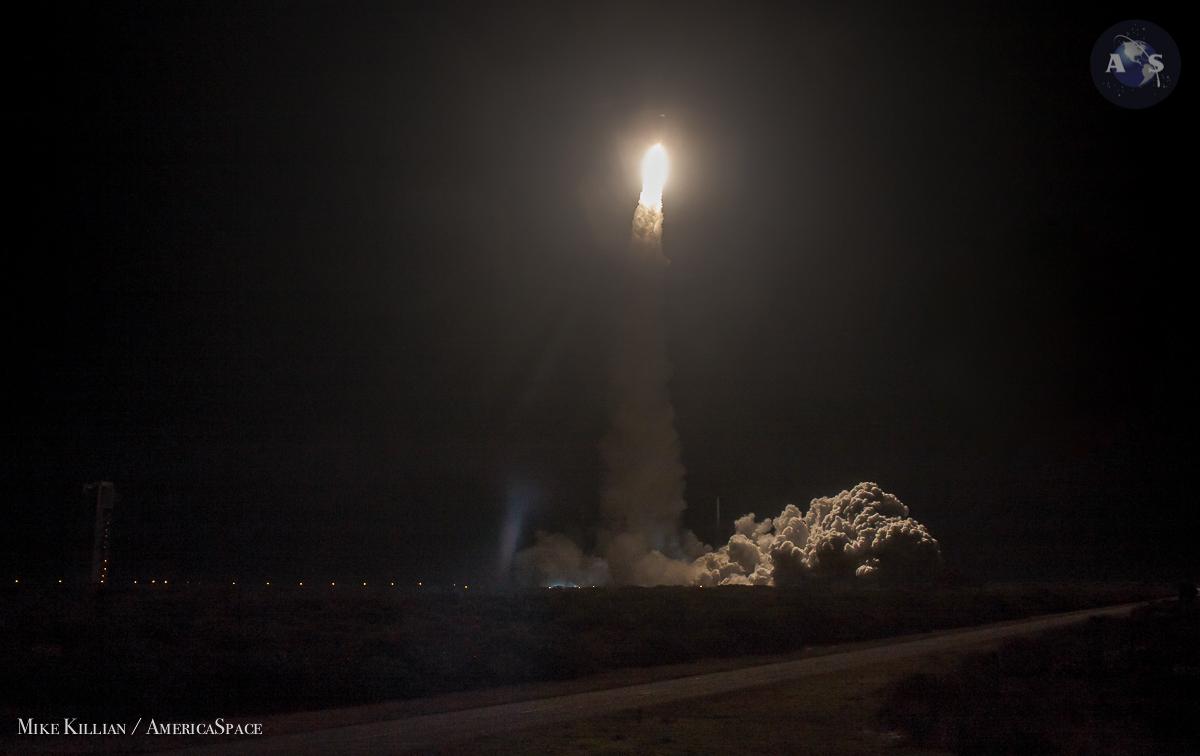
Last year, the initial MUOS network demonstrated new capabilities in the Arctic, an area previously beyond the coverage of UHF satellites and growing in interest for transportation and natural resources exploration above 65 degrees North latitude. The satellites successfully provided almost 150 hours of secure data connections and, for the first time, enabled large-scale data transfers of up to 20 megabytes of documents, photographs, and maps in the Arctic during independent tests by Lockheed Martin and throughout the U.S. Navy’s 2014 Ice Exercise (ICEX) and the U.S. Coast Guard’s Arctic Shield 2014. “MUOS is a game-changer in communications for our warfighters and will allow them to have high-fidelity voice communications, networked team calls and data exchange, including video, with anyone connected to a secure terminal around the world,” said Iris Bombelyn, vice president of Narrowband Communications at Lockheed Martin. “The launch of MUOS-3 will increase our network coverage to about three-quarters of the globe.”
The original contract between Lockheed Martin and the U.S. Navy’s Communications Satellite Program Office was announced in September 2004, extending for seven years and valued at $2.1 billion, for a two-satellite Initial Operational Capability (IOC). That contract has since been extended and present schedules envisage the launch of MUOS-4—which concluded its own environmental testing phase last month—in August 2015 and MUOS-5 in 2016, all utilizing the Atlas V 551 heavylifter. This will produce a constellation of four “operational assets and one on-orbit spare.”
Want to keep up-to-date with all things space? Be sure to “Like” AmericaSpace on Facebook and follow us on Twitter: @AmericaSpace
Missions » MUOS » Missions » MUOS » MUOS-3 »



2 Comments
2 Pings & Trackbacks
Pingback:«Βαρέων βαρών», φωτογραφία της ημέρας | ΠΤΗΣΗ & ΔΙΑΣΤΗΜΑ
Pingback:NAVY’s MUOS-3 Relocates for On-Orbit Operations as MUOS-4 Prepares for Late Summer Launch « AmericaSpace